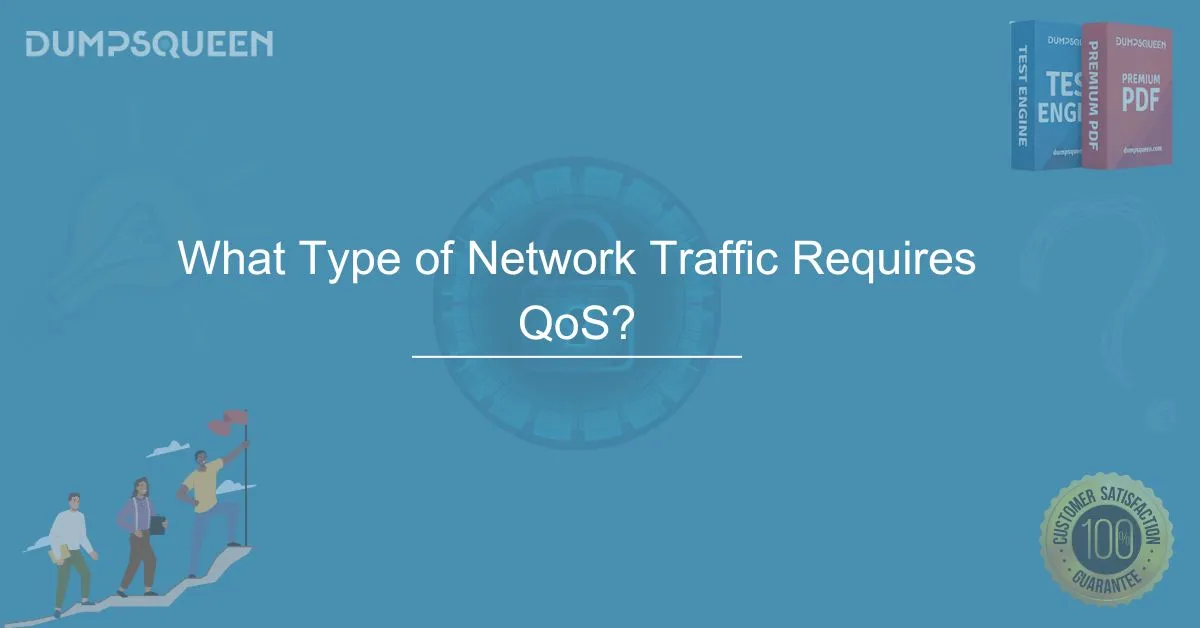Introduction
In the modern digital landscape, network efficiency and performance are crucial for businesses and individual users. As technology advances, the demand for high-speed, reliable, and uninterrupted connectivity continues to grow. Network congestion, latency issues, and packet loss can significantly impact user experience and business operations. To address these challenges, Quality of Service (QoS) plays a vital role in managing and prioritizing network traffic.
QoS ensures that essential applications receive the required bandwidth and network resources to function optimally. This is particularly important for traffic types that demand real-time responsiveness, minimal delays, and uninterrupted transmission. Without proper QoS mechanisms, networks can experience congestion, resulting in poor performance for critical services.
At DumpsQueen Official Website, we aim to provide comprehensive insights into networking technologies. In this article, we will explore the types of network traffic that require QoS, their significance, and the impact of QoS implementation on overall network performance.
Importance of QoS in Network Management
With the increasing reliance on digital applications and cloud-based services, the demand for efficient network traffic management has never been higher. QoS is essential for ensuring a smooth user experience, reducing latency, and preventing network congestion. It allows network administrators to classify and prioritize specific types of traffic based on their importance. Without QoS, all network traffic is treated equally, which can lead to inefficient bandwidth usage and disruptions in critical services.
QoS helps in allocating network resources efficiently by categorizing traffic into different priority levels. High-priority traffic, such as voice and video communication, requires real-time transmission with minimal packet loss. On the other hand, lower-priority traffic, such as file downloads and background updates, can tolerate delays without affecting performance significantly.
Real-Time Voice Communication and QoS
One of the most common types of network traffic that require QoS is real-time voice communication, particularly in Voice over Internet Protocol (VoIP) services. VoIP enables users to make voice calls over the internet, but without proper QoS, these calls can experience disruptions, delays, and poor audio quality. Network congestion can lead to packet loss and jitter, making conversations unintelligible.
QoS mechanisms help VoIP traffic by ensuring that voice packets are prioritized over less time-sensitive data. This results in clear, high-quality voice calls without noticeable delays or interruptions. Businesses and individuals relying on VoIP for communication must implement QoS to maintain effective and professional communication standards.
Video Conferencing and Streaming Services
With the rise of remote work, online meetings, and video streaming platforms, video conferencing and streaming services require a high level of QoS to function efficiently. Platforms such as Zoom, Microsoft Teams, and YouTube demand consistent bandwidth and minimal latency to deliver uninterrupted video experiences.
Poor QoS can lead to buffering, pixelation, and delays in video playback, affecting user engagement and communication effectiveness. To optimize video traffic, QoS ensures that video packets are transmitted with minimal interference, providing smooth streaming and high-quality video conferencing. Businesses, educational institutions, and entertainment providers benefit significantly from implementing QoS for their video services.
Online Gaming and Latency Optimization
For online gamers, network latency and stability are critical factors in ensuring a smooth gaming experience. High latency, jitter, and packet loss can result in lag, delayed responses, and disconnections. Multiplayer games and esports rely on real-time data transmission, requiring optimized QoS settings to prevent performance issues.
QoS in online gaming prioritizes gaming traffic, reducing delays and providing a seamless experience. By implementing QoS, network administrators can allocate sufficient bandwidth to gaming applications, preventing interruptions caused by background downloads or other non-essential network activities.
Cloud-Based Applications and Business Productivity
As businesses transition to cloud computing, cloud-based applications such as Microsoft 365, Google Workspace, and SaaS (Software as a Service) platforms require reliable connectivity and QoS implementation. Cloud applications depend on stable network performance to ensure smooth collaboration, file sharing, and data synchronization.
QoS for cloud-based applications ensures that essential business processes receive the required bandwidth, preventing slow performance and connectivity disruptions. Organizations leveraging cloud solutions must prioritize QoS to maintain productivity and seamless operations.
Mission-Critical Business Applications and QoS Implementation
Enterprise applications such as Enterprise Resource Planning (ERP), financial transactions, and healthcare systems demand strict QoS policies to ensure reliability and security. Delays or data loss in these applications can lead to financial losses, operational inefficiencies, and compromised patient care in healthcare institutions.
QoS strategies for mission-critical business applications involve traffic prioritization, bandwidth reservation, and network monitoring to prevent disruptions. By ensuring that these applications receive dedicated network resources, businesses can maintain seamless and secure operations.
Internet of Things (IoT) and Network Efficiency
The increasing adoption of the Internet of Things (IoT) in industries such as manufacturing, healthcare, and smart homes has created new challenges for network management. IoT devices generate continuous data streams that require reliable network performance and real-time processing.
QoS plays a crucial role in managing IoT traffic by ensuring that time-sensitive data from sensors and automation systems are transmitted without delays. Without QoS, IoT networks can experience congestion, leading to inaccurate data readings and operational inefficiencies. Proper QoS configuration enhances the efficiency and reliability of IoT deployments.
Strategies for Effective QoS Implementation
Implementing QoS effectively requires a strategic approach that aligns with the specific needs of an organization. Network administrators must identify critical traffic types, classify them based on priority, and configure QoS policies accordingly.
Key steps in QoS implementation include:
-
Traffic Identification and Classification: Determining which applications require priority treatment.
-
Bandwidth Allocation and Management: Assigning sufficient bandwidth to high-priority traffic.
-
Traffic Shaping and Queuing Techniques: Managing data flow to prevent congestion.
-
Continuous Monitoring and Optimization: Regularly analyzing network performance and making necessary adjustments.
By following these strategies, businesses and organizations can optimize their network performance, ensuring a smooth and uninterrupted digital experience.
Conclusion
QoS is an essential networking feature that ensures the prioritization of critical applications, enhancing overall network performance and efficiency. From VoIP and video conferencing to online gaming and cloud-based applications, QoS plays a crucial role in maintaining seamless digital experiences. Without QoS, network congestion and latency can negatively impact productivity, communication, and user satisfaction.
At DumpsQueen Official Website, we emphasize the importance of QoS in modern networking. By implementing QoS strategies, businesses and individuals can optimize their network infrastructure, ensuring high-quality performance for essential applications. As digital demands continue to grow, QoS remains a key factor in achieving a reliable and efficient networking environment.
Free Sample Questions
1. What is the primary benefit of implementing QoS for VoIP traffic?
A) Increases overall internet speed
B) Reduces latency and ensures clear voice communication
C) Enhances video resolution in streaming services
D) Improves Wi-Fi signal strength
Answer: B) Reduces latency and ensures clear voice communication
2. How does QoS benefit online gaming?
A) Allocates more bandwidth to social media applications
B) Prioritizes gaming traffic to minimize lag and delays
C) Blocks other network users from accessing the internet
D) Reduces the need for high-speed internet connections
Answer: B) Prioritizes gaming traffic to minimize lag and delays
3. Why is QoS essential for video conferencing?
A) It helps in compressing video files
B) It ensures smooth video transmission without buffering
C) It increases the speed of file downloads
D) It restricts the use of non-essential applications
Answer: B) It ensures smooth video transmission without buffering



